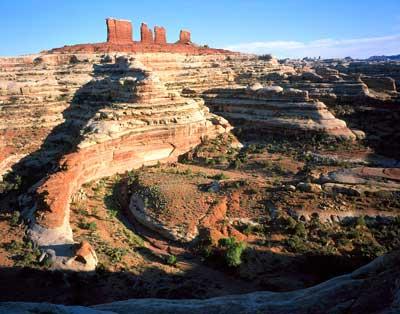A 64-year-old man from North Carolina was injured in a fall during a solo hike in a remote section of Canyonlands National Park last week. Unable to walk, he faced long odds, since no one was aware of his plans or location. What followed was a tale combining grim determination and alert work by rangers.
The saga began when Amos Richards attempted to hike in and out of Lower Blue John Canyon via the entry and exit route between West and Little Blue John Canyons. During the trip, he fell approximately 10 feet trying to gain the wash bottom, suffering extensive leg trauma in the process.
A serious injury anywhere in this vast expanse of Utah canyon and desert country is always a cause for concern, but Richards was faced with some extra challenges. The location of his mishap was near an area known as the Maze District, which is described as "the least accessible district of Canyonlands. Due to the district's remoteness and the difficulty of roads and trails, travel to the Maze requires more time, as well as a greater degree of self-sufficiency. Rarely do visitors spend less than three days in the Maze, and the area can easily absorb a week-long trip."
Richard's injuries were serious enough that he couldn't bear weight on his right leg, but he was hiking alone, and no one else was aware of his plans or his location. As a result, it was unlikely that anyone would be aware of his plight and began a search. In a remarkable tale of determination, Richards began crawling back across the rough desert terrain in an attempt to reach his vehicle.
His grueling effort would last for the next three nights and four days. The hiker reportedly had no overnight gear, warm clothes or a map, and it rained on him several times during his crawl. The only good news may have saved his life: he had taken five liters of water and two power bars with him on his hike.
This was a situation that could easily have ended sadly, but Richard's prospects began to improve when rangers in the park's Island in the Sky District noticed that a campsite in the Willow Flat campground appeared to be unoccupied and abandoned.
That campground is many a lonely mile from Richard's location in the Maze, but investigation by the rangers led them to believe the visitor may have headed for that vicinity.
A search was begun and Richards was spotted from a helicopter in the area of Little Blue John Canyon, just outside the park’s boundary. The victim was flown to Moab Regional Hospital, where he was treated for leg fractures, internal injuries, trauma, and dehydration.
A park spokesperson says Richards is expected to make a full recovery.




Comments
Amos I'm very glad that this is a story of determination by the Park Service and yourself. And it's a reminder.....a lesson to leave a travel plan and exit time with a contact. Something I am guilty of failing to do. I will take your "It can happen to me" to heart. Thanks to the Park Service for the outstanding job they do.
-Shane
I am glad you are recovering. I, too, hike alone and even if it is just a day hike I always carry my first aid/emergency kit. I am guilty of saying I will be at one spot but then go to another. Not on purpose but in the spur of the moment and too many people at the planned spot. I will from now on leave a note in the truck to let someone know where I am.
As a woman I try to be aware of my suroundings and not take chances. This is a lesson for me to be even more careful.
Does anyone know of a website or forum where would-be solo hikers can state what they want to do and see if they can find potential fellow hikers. Often people have travelled a long way and have a set amount of time available, so they need to find someone willing to go with them well in advance, rather than stand around hoping at a trailhead
There's a different wrinkle, but not sure it's the way I'd prefer to get some international exposure. :-)
LIttle Blue John has 2 big raps that I would not do alone. We survived our trip with planning, climbing gear, and Kelseys guide book that would have helped Mr. Amos make better decisions. Little blue, The main, lower Blue, Big drop were all awesome. Too bad he missed the best parts of the trip.
Had he walked down the west fork he would have been better off.
The solution is simple, albeit imperfect. Carry a personal locator beacon (PLB). I don't go anywhere remote on my mountain bike or on foot without carrying my ACR Electronics Aqualink if I'm by myself. Last month, I hiked up the caldera rim on the island of Fogo, in Cape Verde. The trail proved to be much fainter than the map advertised and, soon enough, even with my Garmin GPS (using a GPS also is mandatory in these circumstances), I lost track of the trail. Before long I found myself scaling a sheer face by reaching for handholds and had inflicted a number of cuts on myself on sharp pumice. I kept falling and sliding backward. And I was alone. This was a foolhardy expedition that, by the time I turned back, had long since become too dangerous—all the more so because Cape Verde has no organized rescue capability that I'm aware of. With my PLB, however, if I had incapacitated myself I could (if still conscious) have activated it and I think that one of the PLB-monitoring countries would have tried to rescue me, even if it meant diverting a Portuguese or English warship somewhere off the coast of West Africa.